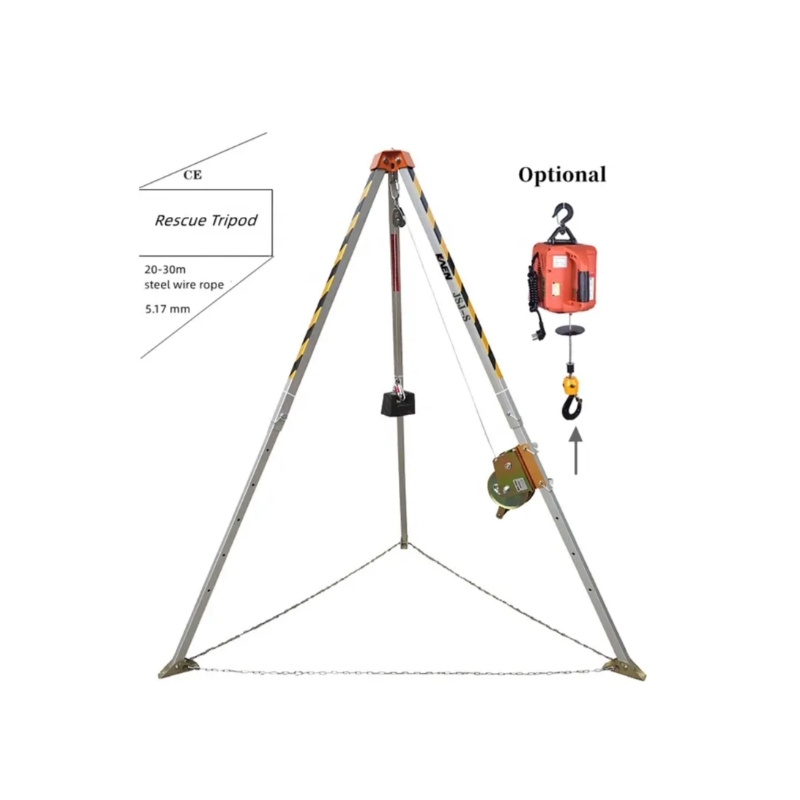A safety tripod stand is an essential tool in safety equipment for various industries, including construction, maintenance, and rescue operations. Selecting the right safety tripod stand can make a significant difference in ensuring safety and efficiency. Here’s a comprehensive guide to help you choose the best safety tripod stand for your needs.
Understand Your Purpose
Before purchasing a safety tripod stand, it’s crucial to identify its intended use. Tripod stands are commonly used for confined space entry, rescue operations, and industrial maintenance. Each application may require specific features, such as weight capacity, height adjustability, or compatibility with other safety equipment.
For example, if you’re working in confined spaces, look for a tripod stand designed for confined space entry, which often includes a winch system for lowering and raising workers.

Check Weight Capacity of safety tripod stand
The weight capacity of a tripod stand is a critical factor. It must support the weight of the worker, their equipment, and any additional tools. Most tripod stands have a weight capacity ranging from 300 to 500 pounds. Ensure the stand you choose can handle the maximum load it will encounter during use.
Overloading a tripod stand can compromise its stability and safety, leading to accidents. Always opt for a stand with a higher weight capacity than your estimated needs.
Evaluate Height and Adjustability
Safety tripod stand comes in various heights, typically ranging from 6 to 12 feet. The height you choose should match the depth of the confined space or the height of the area where you’ll be working. Adjustable tripod stands are highly recommended as they offer flexibility for different scenarios.
Look for stands with easy-to-use adjustment mechanisms, such as telescopic legs or locking pins. This ensures quick setup and adaptability on the job site.
Material and Durability
The material of the safety tripod stand plays a significant role in its durability and performance. Most stands are made from lightweight yet sturdy materials like aluminum or steel. Aluminum tripod stands are corrosion-resistant and easy to transport, making them ideal for outdoor or harsh environments.
Steel stands, on the other hand, are heavier but offer superior strength and stability. Consider the working conditions and choose a material that balances durability and portability.
Stability and Base Design
A stable base is essential for preventing accidents. Tripod stands should have non-slip feet or rubber pads to ensure they remain secure on uneven or slippery surfaces. Some stands also feature a wide base design for added stability, especially in challenging environments.
Check the stand’s stability by testing it on different surfaces before use. A wobbly or unstable tripod stand can pose serious safety risks.
Compatibility with Accessories
Many tripod stands are designed to work with additional safety equipment, such as winches, harnesses, and lifelines. Ensure the stand you choose is compatible with these accessories to create a comprehensive safety system.
For confined space entry, a tripod stand with a built-in winch system is highly recommended. This allows for smooth and controlled lowering and raising of workers, reducing the risk of accidents.
Portability and Ease of Setup
Portability is another important consideration, especially if you need to transport the tripod stand frequently. Lightweight stands with foldable legs are easier to carry and store. Additionally, look for stands that are quick and easy to set up, as this can save valuable time on the job site.
Some tripod stands come with carrying bags or cases for added convenience. These features can make a significant difference in terms of usability and efficiency.
Safety Certifications and Standards
Always choose a tripod stand that complies with relevant safety standards and certifications. Look for products that meet OSHA (Occupational Safety and Health Administration) or ANSI (American National Standards Institute) requirements.
Certified tripod stands have undergone rigorous testing to ensure they meet safety and performance standards. This provides an additional layer of assurance that the equipment is reliable and safe to use.
User Reviews and Reputation
Before making a purchase, research the brand and read user reviews. Reputable brands with positive feedback are more likely to offer high-quality and reliable products. User reviews can also provide insights into the stand’s performance, durability, and ease of use.
Avoid purchasing tripod stands from unknown or unverified sources, as they may not meet safety standards or perform as expected.
Budget and Warranty
While cost is an important factor, it shouldn’t be the sole determinant when choosing a safety tripod stand. Invest in a high-quality stand that offers the features and durability you need, even if it’s slightly more expensive.
